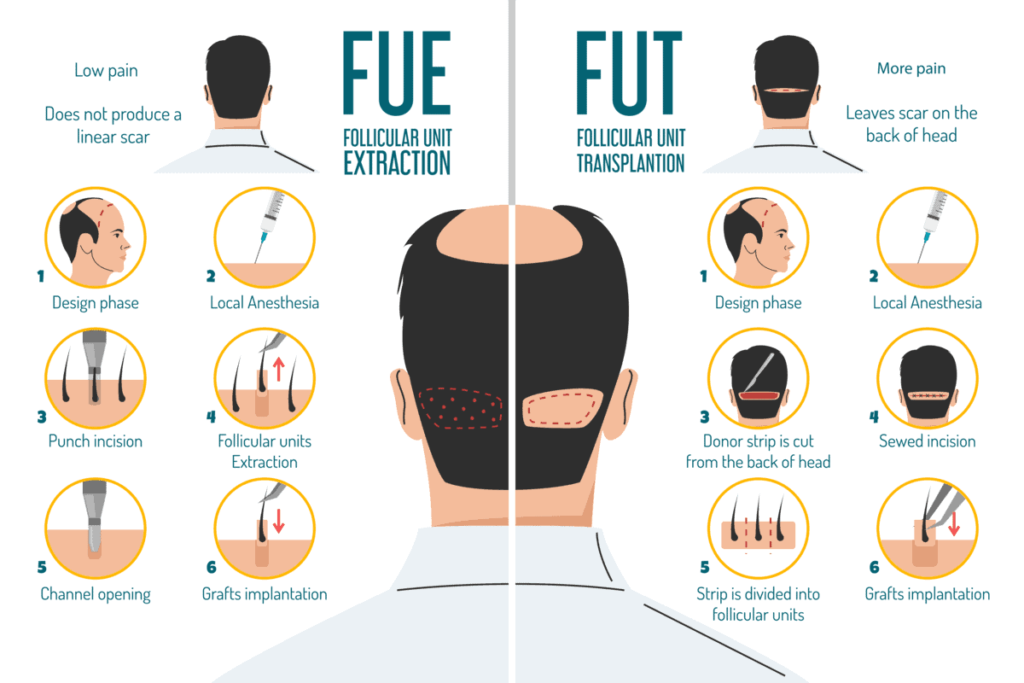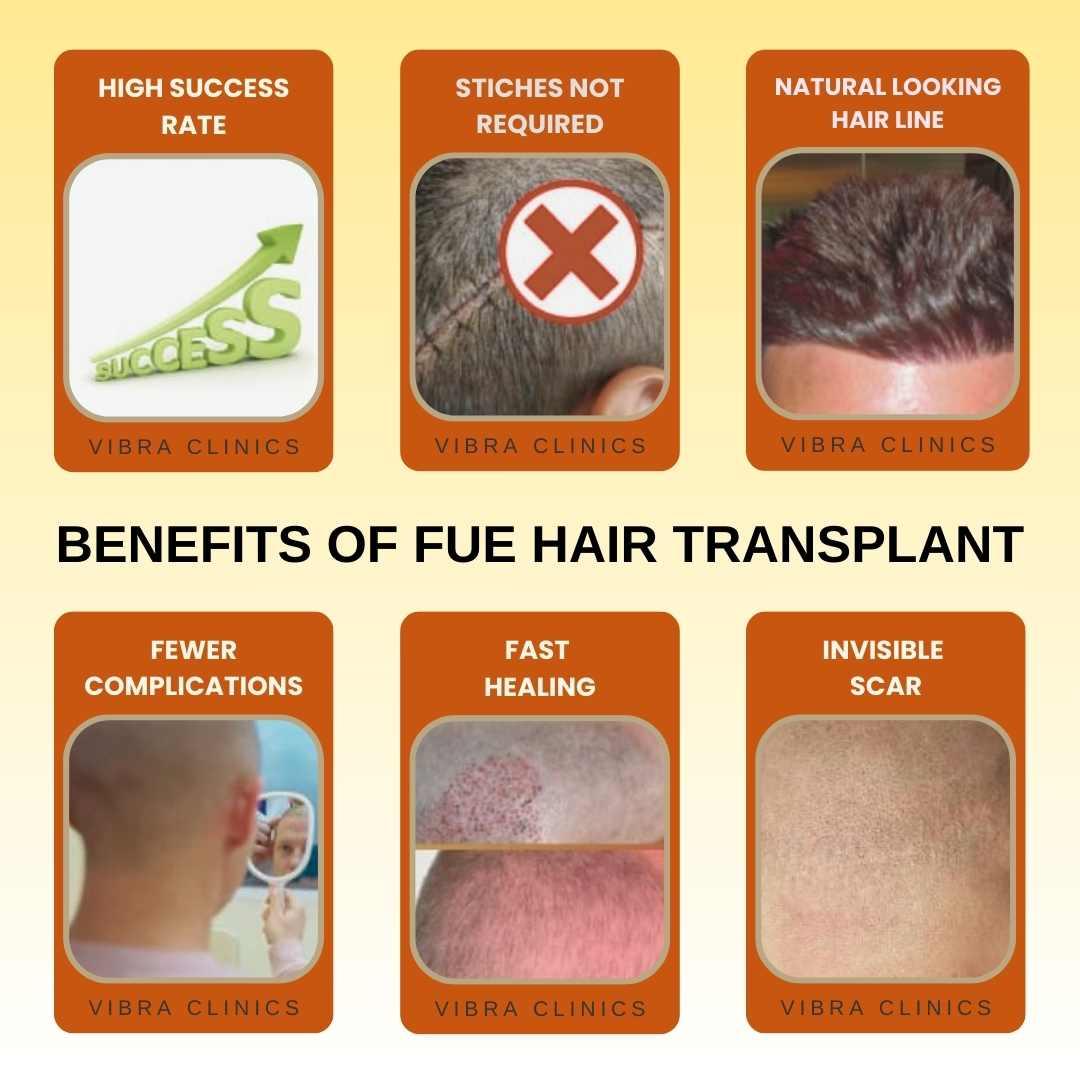Hair Transplant is a blessing for bald people. Hair loss and baldness are common cosmetic problems among men. Initial hair fall and loss can be treated with medicines like minoxidil and finasteride, as well as therapies like PRP (platelet-rich plasma) therapy, GFC Therapy, mesotherapy, LLLT (low-level laser therapy), and micro-needling. However, if left untreated, hair loss can become permanent and lead to baldness, which can be treated with Hair Transplant. We offer Hair Transplant in Udaipur by Best Hair Transplant Surgeon.
Great news! Vibra Clinics now offers FUE hair transplant with improved graft utilization and survival technology. We are one of the few clinics in India offering this.
Male pattern baldness, also known as androgenic alopecia, is primarily caused by genetics. This condition results in hair loss starting at the temples and crown of the scalp. As a result, the frontal hairline may recede and the skin may become visible through the hair. Eventually, the scalp may become smooth due to complete loss of hair follicles. Hair transplantation is the only permanent solution to male pattern baldness. There are two techniques available: FUE (Follicular Unit Extraction) and FUT (Follicular Unit Transplantation)
FUE V/S FUT Hair Transplant in Udaipur

During a FUE transplantation procedure, small hair follicular units are extracted from the back of the scalp with the help of tiny punches. This method involves leaving small holes that are less than 1mm in size. Unlike other methods, FUE does not require big scars or downtime.
On the other hand, FUT involves removing a strip of skin from the back of the scalp, which can cause a noticeable scar. This method also leads to post-operative pain and has a longer recovery time compared to FUE.
Based on the information provided, we can identify some key facts to help you choose the best hair transplant technique for you.
| Parameters | FUE | FUT |
|---|---|---|
| Shaving Required | Required | Required |
| Stitches | No | Yes |
| Scarring | Dot-like invisible scars | Linear scar |
| Pain | Almost Painless | High Postop Pain |
| Donor area healing time | <1 week | 2-4 weeks |
| Recipient area healing time | 10-14 days | 2 weeks approx. |
| Cost | Cheaper | Expensive |
FUE Hair Transplant: Results, Benefits & Duration
Follicular Unit Extraction (FUE) is a technique that involves transplanting individual hair follicles from the donor area to the recipient area. FUE is a minimally invasive procedure that uses advanced hair restoration technology to permanently treat hair loss and provide a natural-looking result. The procedure is safe with minor possible side effects, such as tiny white scars where follicles were extracted.
You may experience temporary side effects that go away a few days after treatment, including swelling, bruising, and sensitivity. FUE is often done in single 6 to 8-hour sessions in a single day. In some cases, a “mega session” may last 10 to 12 hours. FUE is an outpatient procedure, so you can typically go home after each procedure. You don’t have to interrupt your daily routine too much after FUE. However, you should avoid immersing the area in water or doing any rigorous exercise for about a week.
Here are some benefits of FUE hair transplant:
- Minimally invasive: FUE uses small punches to remove individual hairs, leaving no linear scarring.
- Fast recovery time: Usually just one week, compared to two weeks with FUT.
- Natural-looking results: FUE offers natural-looking results, minimal scarring, and no visible donor site marks.
- Good quality of punches: Leaves practically no visible scar in the donor area either beard or scalp.

FUE Hair Transplant : 7 Step Treatment Process
FUE is a minimally invasive procedure that uses cutting-edge hair restoration technology to treat hair loss permanently and with a natural-looking result. The doctors use follicular unit grafts, and it is an outpatient treatment to restore your hairline and growth pattern. When it comes to Hair Transplant in Udaipur, we are only clinic that uses improved graft utilization and survival technology (i-GUST) for optimum results. The following are the steps involved in a typical FUE hair transplant procedure:

- Consultation and preparation: The doctor examines the patient’s scalp and hair loss pattern to determine the number of grafts required for hair transplantation, along with a one-on-one consultation to discuss medical history and expectations.
- Hairline Design: A proper hairline design is the next stage. The doctor will draw the hairline on the scalp to ensure that it looks natural and aesthetically pleasing.
- Local Anesthesia: In the next step, local anesthesia is injected into the scalp to extract the hair follicles.
- Extraction: The doctor extracts hair follicles with a punch tool and stores them in a solution.
- Graft Preservation: Follicles are sorted and prepared for implantation. Damaged or weak ones are discarded.
- Implantation: The doctor will make holes and place hair follicles at the right angle for a natural-looking result.
- Post-op Care: The doctor will provide post-procedure instructions regarding scalp and hair care.
Recovery and After Care
After the FUE hair transplant procedure, it is important to take proper care of the scalp and hair to ensure a smooth recovery. Here are some general guidelines for recovery and aftercare:
- Bandaging: The extraction zone is bandaged to keep the small incisions clean from any harmful bacteria and dirt. It is recommended to keep the bandage on until at least the next morning.
- Protective cap: A protective cap is provided that shields your hair from the elements for the next few days. The surgeon will discuss the duration of time a patient needs to wear this cap.
- Medications: An aftercare package containing all the necessary medications and materials needed to keep your hair and scalp in the best possible condition is provided.
- Washing: Don’t wash your hair or shower for at least 3 days. Use gentle, unscented shampoos for a few weeks once you start washing your hair.
- Avoid alcohol and smoking: Avoid alcohol for 3 days after the procedure and abstain from smoking for two weeks after the procedure.
- Strenuous activities: Avoid strenuous activities for a few days and follow the doctor’s instructions for washing and caring for the scalp.
- Follow-up consultations: Follow-up consultations may be required, and access to our surgeons throughout your recovery with any questions is provided.
- Review and follow-up: A 1-year review and follow-up are required with medications and PRP / GFC Therapies for optimum output.
Risks and Side Effects
Hair transplantation is generally a safe procedure with minor possible side effects. However, as with any type of invasive procedure, there’s always a small risk of bleeding, infection, and an allergic reaction. Possible complications and side effects of hair transplant procedures include:
- Swelling
- Bleeding
- Pain
- Numbness (This is usually temporary, but it can be permanent.)
- Inflammation or infection of the hair follicles, which is known as folliculitis
- Itching
- Crust that forms on the areas of the scalp where hair was removed or implanted
- Loss of feeling on your scalp
- Scarring